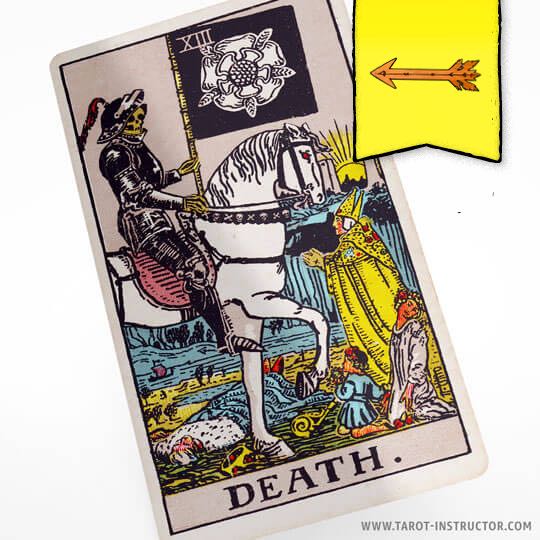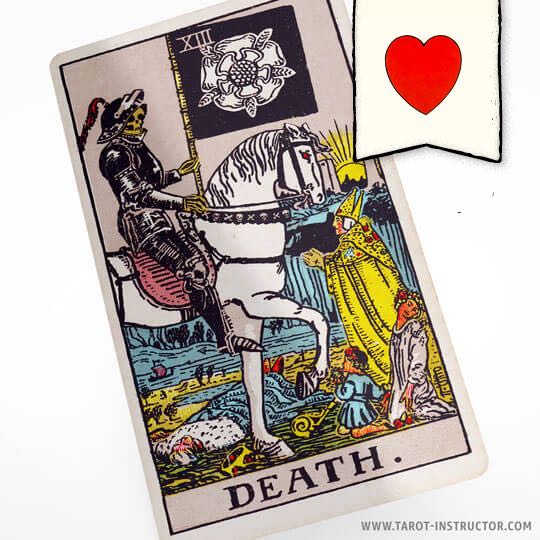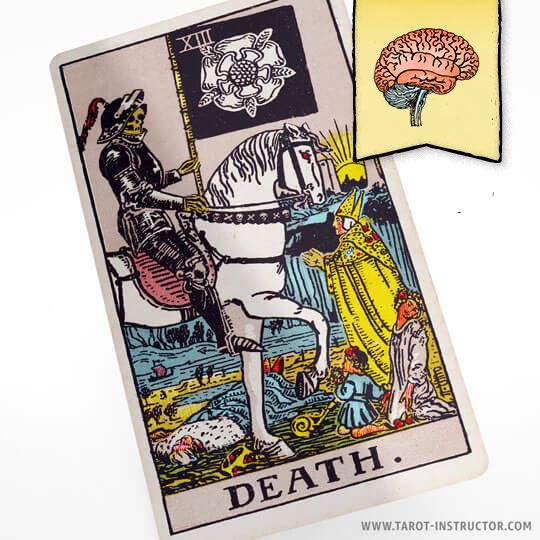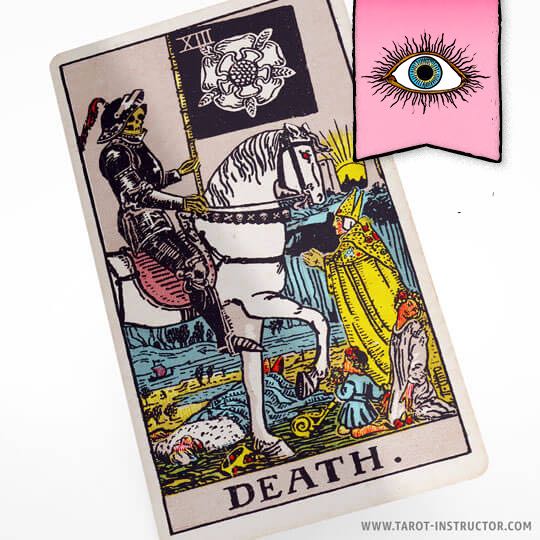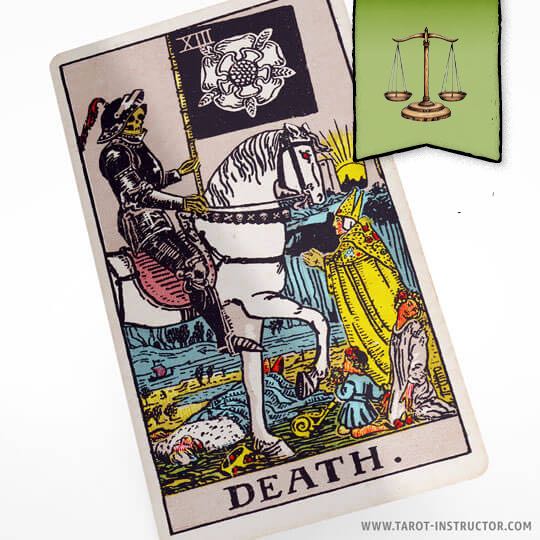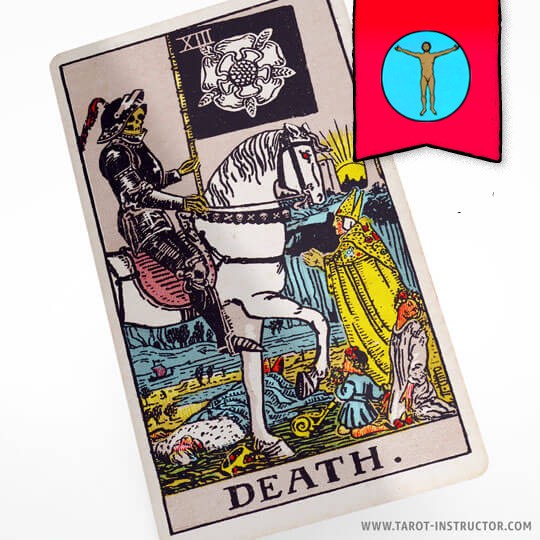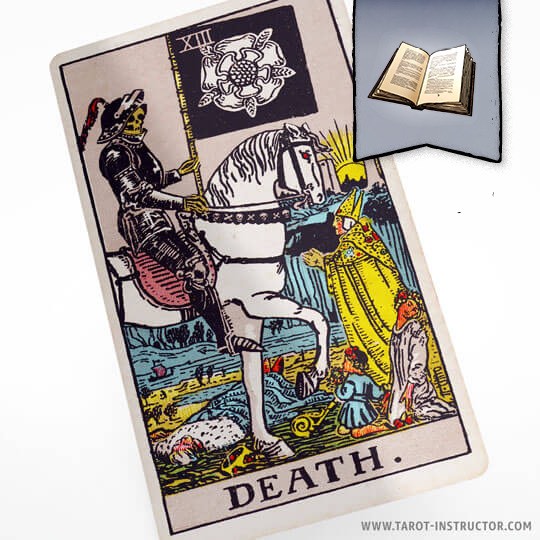Death as advice
„Release what no longer serves you to welcome new beginnings.“
Death tarot card features following symbolic elements
Understanding the Death Card as Past Upright and Reversed
The Death card is one of the most misunderstood cards in the Tarot deck. Contrary to its ominous name, the Death card signifies transformation, endings, and new beginnings. When drawn in the context of the past, the Death card as past can provide profound insights into various aspects of relationships—whether they are potential, new, existing, or former. In this article, we will explore the meanings of the Death card as past in the context of relationships, both upright and reversed, providing a comprehensive understanding of its implications across different relationship scenarios.
The Death Card: An Overview
Before diving into its implications in relationships, it’s essential to understand what the Death card as past represents in the Tarot. The Death card is typically numbered as XIII (13) and symbolizes the end of one phase and the beginning of another. It embodies themes of transformation, change, and the cyclical nature of life. When interpreted in the context of the past, the Death card as past can indicate a significant transition that has profoundly influenced one’s approach to relationships.
The Death card as past can signify the ending of old patterns, beliefs, or connections that no longer serve a purpose. This transformation often leads to personal growth and allows individuals to embrace new opportunities. The energy of the Death card urges individuals to release what no longer fits their life narrative, paving the way for renewal and rebirth.
The Death Card as Past in Potential Relationships
Upright: In the upright position, the Death card as past signifies a time of significant transformation concerning potential relationships. This card suggests that the individual has undergone profound changes in their attitudes and beliefs that have shaped their approach to new connections. The past may have included the release of old patterns or toxic relationships that allowed them to embrace new possibilities.
This transformation likely attracted new people into their life, as the individual may have shed past baggage. The energy of the Death card encourages an openness to new experiences and connections. The person may have felt empowered to explore relationships without the weight of previous disappointments or fears. This openness likely fostered an environment where potential relationships could blossom, characterized by a sense of authenticity and understanding.
Reversed: When the Death card as past appears in reverse in the context of potential relationships, it can indicate stagnation or an inability to let go of past experiences. Looking back, one might realize that fear of change or attachment to previous relationships hampered their ability to form new connections. The reversed Death card as past might suggest that the individual was clinging to outdated beliefs or fears, thus preventing themselves from embracing new possibilities.
In this state, the individual may have found themselves stuck in a cycle of indecision, hesitating to move forward with potential partners. This mindset could lead to missed opportunities for connection, as they may have been unable to fully engage with new people. The reversed Death card as past serves as a reminder that to find love and companionship, one must be willing to confront their past and embrace change.
The Death Card as Past in New Relationships
Upright: The Death card as past in an upright position concerning new relationships reflects a time filled with transformation and growth. The past may have been marked by a willingness to shed old beliefs and embrace new connections. This transformative energy allowed the individual to approach potential partners with a sense of renewal and hope.
During this period, new relationships may have blossomed rapidly, fueled by mutual understanding and shared experiences. The upright Death card indicates that the individual was likely open to exploring these new connections without the fear of previous emotional baggage weighing them down. This openness could have led to deep and meaningful connections, characterized by a willingness to grow together.
Reversed: When the Death card as past appears reversed in the context of new relationships, it often highlights a past marked by resistance to change or an inability to fully engage in new connections. The individual may have approached new relationships with skepticism or fear, which could have stemmed from unresolved issues from previous experiences. This energy may have created a barrier to forming authentic connections.
Reflecting on this period, the individual might recognize how their reluctance to embrace change hindered their ability to form meaningful relationships. The reversed Death card as past can also indicate a tendency to repeat old patterns, leading to relationships that lack depth or fulfillment. This serves as a crucial reminder that true growth requires an openness to transformation and the willingness to let go of what no longer serves a purpose.
The Death Card as Past in Existing Relationships
Upright: The Death card as past in an upright position regarding existing relationships suggests a time of profound change and growth. The individual may have experienced a transformative phase within their current relationship, where both partners were willing to evolve together. This positive energy could have fostered a deeper bond characterized by mutual support and understanding.
In this context, the Death card encourages couples to embrace change within their relationship. This may have involved letting go of old grievances, adopting healthier communication patterns, or exploring new interests together. The energy of the upright Death card indicates that both partners were likely willing to take risks for love, which helped keep the relationship dynamic and vibrant.
Reversed: When the Death card as past appears reversed in the context of existing relationships, it often points to a period of stagnation or resistance to change. The individual may have felt trapped in their relationship, where growth and transformation were replaced by routine and predictability. The reversed Death card can signify a lack of communication or an unwillingness to confront underlying issues that need resolution.
This energy may have led to feelings of frustration or dissatisfaction within the relationship. The individual might have looked back at this time and recognized that their reluctance to engage with their partner in a transformative way contributed to a decline in intimacy. It serves as a reminder that relationships require ongoing effort and a willingness to embrace change to thrive.
The Death Card as Past in Ex-Relationships
Upright: In the context of ex-relationships, the Death card as past upright can signify a past marked by profound growth and valuable lessons learned. The individual may have approached their previous relationship with an open heart, even if it ended. The experiences gained from this relationship were likely enriching and helped shape their understanding of love.
Reflecting on this ex-relationship, the individual might recognize the transformative power it had on their life. Even though it may have ended, the lessons learned were essential for their personal growth and prepared them for future connections. The upright Death card as past suggests that this relationship was a necessary step in their journey toward deeper self-awareness and understanding of love.
Reversed: When the Death card as past appears reversed in the context of ex-relationships, it may indicate a time of regret or unresolved issues. The individual might look back on their previous relationship and see it as a series of mistakes or missed opportunities. This energy suggests that the person may have acted impulsively or without proper understanding, leading to unresolved feelings that lingered.
The reversed Death card as past can also signify a reluctance to move on from the past. The individual may find themselves stuck in a cycle of nostalgia, longing for what once was without acknowledging the reasons for the relationship’s end. This reflection can serve as a crucial lesson: to truly move forward, one must learn from past mistakes rather than dwell on them. Acknowledging these lessons is essential for personal growth and future relationship success.
Conclusion
The Death card as past is a card rich with meaning and implications, especially when considering its influence on relationships. In its upright position, it represents transformation, growth, and the shedding of old patterns, while in its reversed state, it warns of stagnation, missed opportunities, and unresolved issues. By examining the Death card as past in various relationship scenarios—potential, new, existing, and ex-relationships—we can gain valuable insights into our past behaviors and choices.
Understanding these dynamics can empower individuals to embrace their journey toward love with a renewed sense of clarity and purpose. Whether learning from past mistakes or celebrating transformative experiences, the Death card as past reminds us that every relationship contributes to our growth and understanding of ourselves and others. Ultimately, the journey through love is a transformative experience filled with lessons that shape who we are and who we aspire to be. Embracing the energy of the Death card as past can lead to profound self-discovery and a deeper understanding of what we seek in our relationships.
Source: Wikipedia Death tarot card
Reddit The Death Card
Quora What is the meaning of the Death card?
